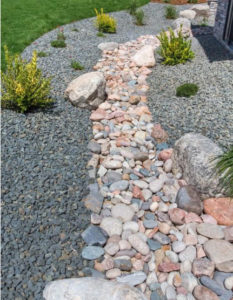
Water is a house’s sneakiest enemy. While fire will turn a home to ash in a matter of hours and heavy things like tree limbs or a wrecking ball are obvious dangers, water slowly and surreptitiously weakens a home when it seeps into spaces it isn’t supposed to be. Water damage most often occurs gradually over time, as drips and drops wear through the materials of your home and cause extreme structural issues — while bringing health hazards like mold and disease.
Alongside plumbing problems and roof leaks, drainage difficulties are among the most common causes of water damage in residential homes. If you notice water pooling up against your structure after a rainstorm — or even after your lawn’s sprinklers turn off for the day — your yard likely has trouble draining excess water properly, which means you are facing serious home repairs in time.
Fortunately, poor drainage isn’t necessarily a death sentence. You can repair your yard’s ability to drain water with these simple tips and tricks.
Elongate Your Downspouts and Discharge Pipes
This is the easiest of all fixes, so if you can, you should start here. Often, water pools around your home because that’s where it comes out of downspouts or discharge pipes. By relocating where that water exits the pipe, you can avoid the problem of poor drainage.
Downspout extenders are relatively inexpensive and can be attached in a matter of minutes. You can even acquire a flexible extension, so you can maneuver the end of your downspout to find the optimal location to release water. It takes slightly longer to move the downspout to a different, better-draining part of your yard, but that is also an option if you cannot reach a well-draining spot with an extender.
You should also keep an eye out for poor drainage around the discharge pipes of systems like sump-pumps and air conditioners. Though these won’t spew water the way downspouts will, the relatively slow drip of water can also cause damage when it is improperly placed. You might need to extend or relocate these discharge pipes, as well.
Alter Your Sprinkler Pattern
Sprinklers and other automated landscape watering systems make it easy to enjoy a verdant yard, but they also potentially increase the likelihood of drainage problems. Its possible that your sprinkler system develops a leak in a line below the surface of your soil, resulting in oversaturation of the land surrounding your home. You might not be aware of a leak in your sprinklers until you see an excessively high water bill or notice water damage to the exterior of your home. Then again, it’s also possible that your sprinklers are poorly aligned, resulting in water pooling in areas of your yard that don’t need any hydration.
In either case, it’s a good idea to contract a lawn care service with experience in sprinkler maintenance and repair. Professionals know the signs of a poorly functioning sprinkler system and can tweak and tinker with your sprinklers to ensure they are watering efficiently without doing damage to your property.
Create a Creek or Swale
 If you can’t easily fix your drainage issue with the above tricks, you probably need to bring out your shovels to dig ditches to carry the water away from your home. There are many different kinds of trenches you can create for better drainage, but the easiest is a simple creek or swale. This is a gentle, shallow drainage ditch that hugs the base of a slope to collect runoff water and channel it in a particular direction. You should strive to landscape around your ditch, perhaps with attractive rocks and water-loving plants, to ensure the functional feature looks good both with water and without.
If you can’t easily fix your drainage issue with the above tricks, you probably need to bring out your shovels to dig ditches to carry the water away from your home. There are many different kinds of trenches you can create for better drainage, but the easiest is a simple creek or swale. This is a gentle, shallow drainage ditch that hugs the base of a slope to collect runoff water and channel it in a particular direction. You should strive to landscape around your ditch, perhaps with attractive rocks and water-loving plants, to ensure the functional feature looks good both with water and without.
Supplement Your Soil
If you suffer from soil with a high clay content, you might never achieve the level of drainage you need to keep your property safe. Fortunately, it is possible to alter the composition of your soil, making it more capable of absorbing excess water and carrying it away from your home. The general advice to those contending with clay soil is to liberally mix in organic materials, such as:
- Compost
- Sawdust
- Manure
- Leaf litter
- Seaweed
- Peat moss
- Bark
You might also consider creating lasagna beds in your yard, which requires creating different layers of materials to facilitate drainage, add nutrients and change the texture of your soil.
Drainage problems inevitably result in serious and expensive water damage, which means you need to address your property’s drainage ASAP. While most issues can be resolved with some simple fixes, if your drainage troubles linger, you should be willing to call a drainage expert. Water damage is always worse than the expense of preventative drainage maintenance.



Comments are closed.